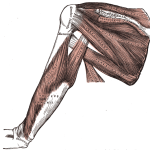This is real folks. about 2 years ago I fell hard on the cement and injured my shoulders and “planted my hands and knees into the cement.
I was in shock and after 5 to 10 minutes finally managed to slowly struggle up. -grateful that I could move.
Since then I’ve tried many things to get “back to normal” ,including physical therapy, acupuncture, homeopathy, kinesiology, some exercise and stretching, supplements, Chiren, trigger point release… and to say there has been no magic bullet is an understatement. I continue to have my shoulder evaluated and accept and practice heat relief and stretches with homeopathic and acupressure relief.
So now I am going to take on Brad Walker’s system to help move me closer to full recovery. Listen to his video and see if it is for you. I’ve interviewed Brad and he is likeable, extremely well trained and has years of professional experience.
So tonight is my first night working his stretching program to help heal my rotator cuff issues. I will keep you posted and if you try his techniques, please post your results here for all to see. Click here for the link.

Remember
Rotator Cuff Injury Facts
The rotator cuff is made up of four muscles that move and stabilize the shoulder joint. Damage to any or all of the four main muscles and the ligaments that attach these muscles to bone is possible. Acute injury, chronic overuse, or gradual aging or excessive slouching while sitting, working or standing can lead to shoulder impingement and pain. This damage can cause disability with decreased range of motion and use of the shoulder joint.
The shoulder is a ball-socket joint that allows the arm to move in many directions. The rotator cuff muscles
supraspinatus, infraspinatus, subscapularis and teres minor stabilize and move the shoulder joint and adjust the position of the humeral head of the arm and scapula (the shoulder blades) during shoulder movement.
Other muscles that assist move and stabilize the shoulder include the deltoid, teres major, corachobrachialis, latissimus dorsi, and pectoralis major.
When the rotator cuff is injured pain, limited range of motion, swelling caused by fluid accumulation can occur and over time calcium can build up and bring on more pain and movement issues.
Injury can vary from a temporary mild strain and sore tight muscle or tendon and inflammation to a partial or complete tear of the muscle that might require surgery or extended rehab.
If you are having lots of pain do not do lots of exercises-error on the side of caution rest and use cold and heat and seek medical care.
What to learn how to help yourself to a speedier recovery?
Pain Relief Master Class
